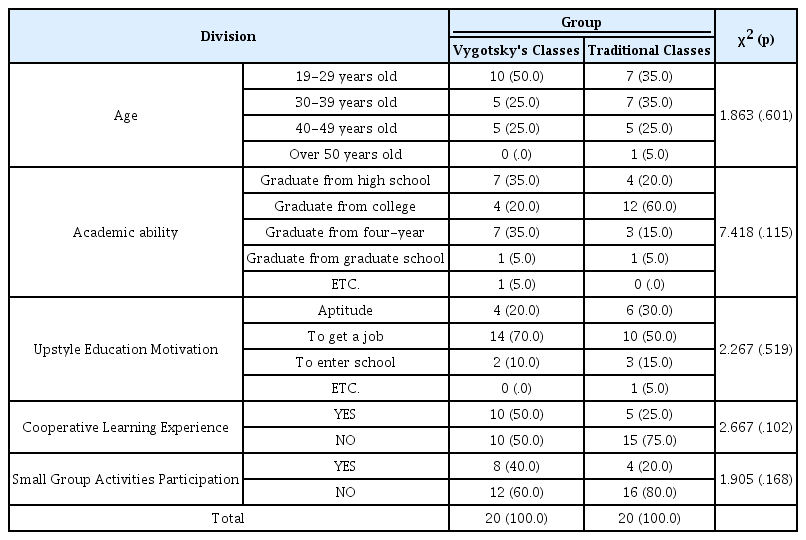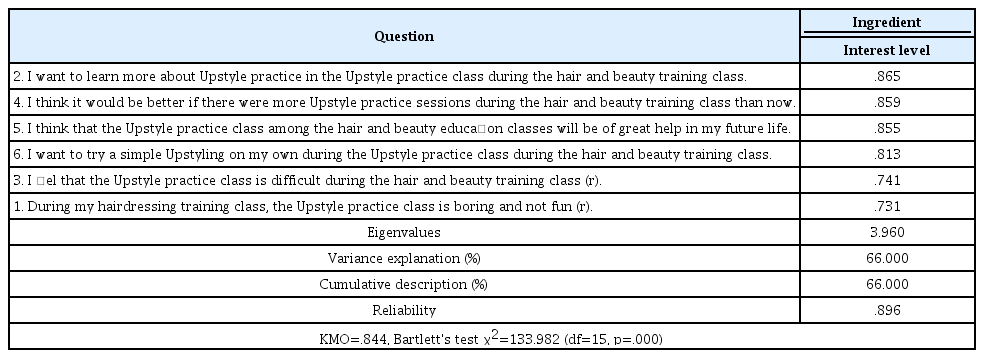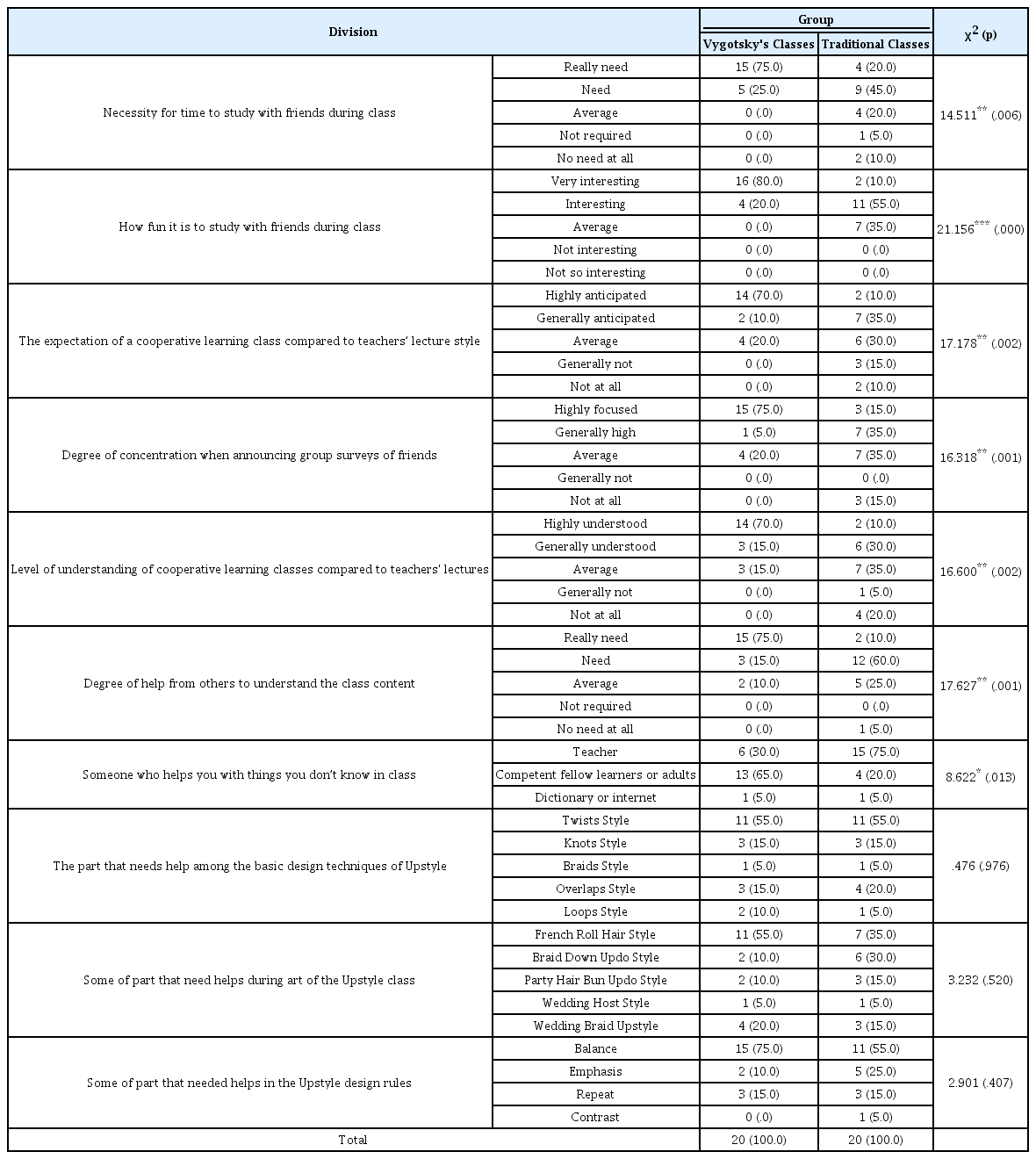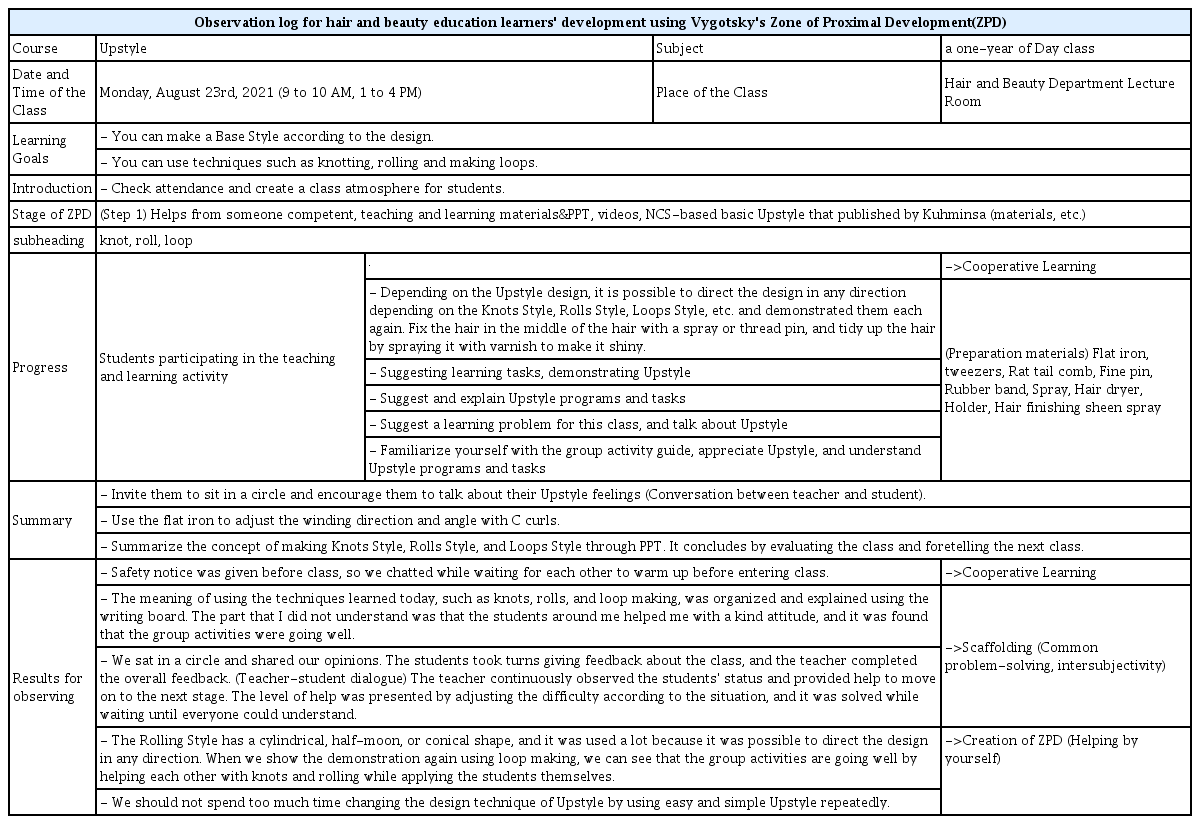비고츠키의 근접발달영역을 활용한 헤어미용교육의 학습자 발달을 위한 연구
A Study on the Development of Learners in Hairdressing Using Vygotsky's Zone of Proximal Development
Article information
Trans Abstract
Among the hair and beauty subjects, “Upstyle practice” education is not a regular curriculum but a “separate subject” that is “opened separately by researchers” and is a subject that is not included in the national technical qualification (beautician) exam, but is cooperative learning for learners. This is because it is possible to show artistry through this, and it is judged that it is appropriate to present the development of learners because of its easy participation and high utilization, and it can be selected as a subject for research and experimental research. The purpose of this study is to promote learner development and suggest educational effects by setting scaffolding and measuring interest and learning attitudes in small-group cooperative learning of Vygotsky's Zone of Proximal Development Theory. In the theoretical study, as a literature review on Vygotsky's educational theory, the researcher used Vygotsky's Zone of Proximal Development (ZPD). was designed. Classes using Vygotsky's Zone of Proximal Development showed relatively high interest and learning attitudes compared to traditional classes. can see. In the future, it is expected that continued research will be conducted on the content of hair and beauty practice courses that can be incorporated into daily life naturally.
I. 서 론
현대의 교육은 참여와 협력, 소통을 통한 감성·인성을 기르는 창의적인 인재를 육성하기 위하여 예체능 교과가 보완되고 영향력이 커지면서 헤어미용교육의 커리큘럼 개선 및 보완이 중요해졌다(Lee, 2019). 그러나 헤어미용실습 교육과정의 학습체계를 형성함에 있어서 학습자의 발달과 성숙을 고려하지 않은 교육방식이 아직도 시행되고 있다. 즉 교사 중심의 교육이 행해지고 있는 상황에서 눈높이에 맞는 체계적이고 보편화된 교육이 실현되어야 한다는 목소리가 커지고 있다(Kang, 2007). 학습자 중심의 능동적인 학습으로 전환하고 폭넓은 학습 환경을 제공하기 위해서는 일선에서 많은 노력이 필요하며, 학생과 교사의 충분한 상호작용이 이루어져야 한다(Jin, 2009).
한편 구성주의 교육학자들은 새로운 교육이론을 도입하는 노력을 지속적으로 해왔는데, 특히 러시아 교육학자인 레프 비고츠키(Lev Semenovich Vygotsky, 1896-1934)의 근접발달영역 이론의 대안점을 제공하였다. 근접발달영역과 협동학습을 강조한 사회적 구성주의 교육심리학자인 비고츠키는 유능한 능력의 동료 학습자, 성인의 도움을 받아가며 발달해 가는 것이 더 교육이 효과적이라고 밝히고 있다(Kim, 2017).
본 연구는 근접발달영역을 활용한 교육과정으로서 기술교육원 헤어뷰티과 정규교육과정이 아닌 별도의 교과목인 업스타일실습을 연구자가 별도로 개설하여 수행하고, 사회적 구성주의 교육심리학자 비고츠키(Lev Semenovich Vygotsky, 1896-1934)의 근접발달영역이론을 적용하고자 한다. 비고츠키의 근접발달영역 이론을 헤어미용교육 중 업스타일실습 수업에 적용한다면 보다 개선된 학습효과가 있을 것으로 기대된다.
헤어미용교육을 받고자 하는 학생 수가 매년 증가하는 상황 에서 교육프로그램을 근접발달영역에 적용하여 학습자 발달을 돕고 질적으로 교육을 향상시킬 수 있는 연구가 절실히 요구되는 시점이다. 그러나 지금까지의 선행연구를 살펴보면, 근접발달영역에 기초한 연구는 교육학(Seo, 2012), 국어국문학(Kim, 2012), 국어교육학(Yoon, 2014), 영어(Ahn, 2014), 음악(Lee, 2015), 수학(Lee, 2016), 유아교육학(Kim, 2021)의 연구가 주를 이루어 헤어미용교육에 비고츠키 이론을 적용한 연구는 미미한 실정이다.
헤어미용교육에 관련하여 비고츠키 교육이론을 적용한 헤어 커트 실습 교과지도 방안 연구(승인번호 SMWU-1912-HR-129-01)를 시행하고 발표(한국미용학회지, 제27권 제2호, (2021). pp. 464-477)한 바 있으나, 보다 심도 있는 후속연구로 학습자 발달을 도모하고 교육효과를 제시하고자 한다. 헤어미용교과 중에서도 업스타일실습 교육은 정규교육과정이 아닌 별도의 교과목으로 연구자가 별도로 개설하여 수행하는 과목으로, 국가기술자격증(미용사)시험과목에는 포함되지 않으면서도 학습자들의 협동학습을 통해 예술성을 발휘할 수 있으며, 학습자의 참여유도가 용이하고 활용도가 높아 학습자의 발달을 제시하기에 적절할 것으로 판단하고 이를 조사연구 및 실험연구의 교과로 선정할 수 있기 때문이다. 본 연구는 비고츠키 근접발달영역이론의 소그룹 협동학습에 있어서 비계를 설정하고 헤어미용교과 중 기술교육원에서 수업을 설계하여 흥미도와 학습태도를 측정함으로써 학습자 발달을 도모하고 교육효과를 제시하는데 연구의 목적이 있다. 이 연구는 학습자 중심 교육으로서, 연구대상자는 헤어미용교육의 학습자로서 연구에 참여하여 업스타일실습을 통해 실력을 향상시키고 교육적 이득을 얻을 수 있다. 업스타일실습 수업을 비계설정에 따라 단계별로 실시함으로써 학습자 발달을 위한 실증적 자료를 제공하는데 연구의 의의가 있다.
II. 이론적 배경
1. 구성주의 교수-학습원리
구성주의자들은 자신만의 경험을 가지고 있으며 지식이라는 것은 개인이 가지고 있는 주관적 경험의 상호작용을 통해 구성된다고 보았다.
첫째, 학생 스스로가 학습의 주체가 되는 것을 의미하며 주관적 경험과 사회문화적 상호작용을 통해 구성되는 것이라는 인식론적 근거를 보면, 학습자는 더 이상 수동적 존재가 아닌 학습의 주체라는 것을 의미한다. 이처럼 구성주의에서는 학습자 중심의 학습을 강조하고 교수-학습 상황도 학습자들은 자율적이고, 적극적으로 생각과 능력을 발휘할 수 있는 환경을 만들어 주어야 한다. 둘째, 자아성찰적사고(Learning by reflection) 이다(Kang, 1998). 학습자들이 기존 지식과 개념을 활용할 수있는 학습환경, 문제해결을 위한 탐색과 사고에 필요한 학습환경으로 깊이 구성되어야 하며 의사결정이나 미래에 대한 예측 등을 가능하게 하는 고차원적인 사고기능을 강화하는데 도움이 될 수 있다. 셋째, 협동학습(Learning by Collaboration)이다. 구성주의에서 지식은 개인의 인지적 경험과 사회문화적 요소와 상호작용으로 이루어지는 것을 의미하며, 따라서 교수-학습 에서는 학습자가 속해 있는 구성원간의 협동학습의 환경이 전제로 구성되어야 한다. 나아가 구성주의적 교수학습에서는 협동학습이 구성되어야 한다. 이 원리가 비고츠키의 근접발달영역(ZPD : Zone of Proximal Development) 이론과 연결되어 구성주의적 학습이론의 역할을 하게 된다. 넷째, 교육과 실생활과의 연계성이 필요한 것은 학습은 항상 구체적인 상황 속에서 이루어지고 강조하기 때문이다(Kang, 1998). 다섯째, 구성주의적 교육방법으로 실행하기 위해서는 교사 역할은 동료학습자 (Co-learner)이며, 학습을 돕는 조력자(Scaffolder)이다. 학생의 능동적 지식구성으로 학습환경의 피드백을 통한 반성적사고를 가지고 있으며 교수매체를 활용하는 것이 교사의 역할이 된다. 학습자가 주체가 되어 지식을 스스로 어떻게 구성되었는지에 대한 중점을 두고 있다(Lee, 2021). 자신이 속한 사회의 구성원들에게 영향을 받으면서 학습자가 주인의식과 함께 정보화 시대로 넘어가면서 대안적 교육패러다임으로 가르치는 교사 중심에서 학습자 중심의 교육으로 전환을 시도하며 교사보다는 학습자에 초점을 맞추고 제안하고 있다(Kim, 2019).
2. 비고츠키의 사회적 구성주의 교수학습이론
1) 비고츠키의 생애와 업적
레프 비고츠키는 구소련의 심리학자로 1896년 11월 17일 벨라루스의 출신으로 유복하게 성장하였다. 또한 고멜 사범대학에서 심리학 실험실을 조직하면서 연구 활동을 하였고 무리한 연구로 인하여 1934년 6월 11일 37세의 젊은 나이에 결핵으로 숨을 거두었고 ‘심리계의 모차르트’ 라고 불리기도 하였다. 그는 실험을 통해 ’교육심리학, ‘사고와 언어’를 저술하였고, 현재에도 새로운 연구가 지속되고 있으며 정신지체아 등 비정상 아동에게 관심을 가지면서 수많은 연구에 전념하였다(Lee, 2019). 그의 가장 중요한 저서 중에서 병상에 누워있을 때 ‘사고와 언어’는 사후에 출판되었고 심리학자로서의 천재성을 발휘한 비고츠키는 전 생애에 걸쳐 「Thought and Language」, 「Mind in Society」등 180여 편의 논문과 책을 집필하여 후대 심리학자 및 교육학자들에게 사회․문화적 심리학적 이론의 기초가 되고 있다(Ju, 2008).
2) 내면화
Vygotsky는 고등정신기능은 ‘개인 간 정신 기능(interpsychological functioning)’의 형태에서 ‘개인 내 정신 기능(intrapsychologial functioning)’으로 내면화(internalization) 과정을 거치면서 발달 한다고 보았다. 그리고 내면화는 사회적 상호작용을 통해 생성되고 유지되는 것으로 심리적 현상으로 변형시키는 과정이라고 본다(Kim, 2018). 외적인 수준에서 내적 수준까지 실행되는 과정을 내면화라 부른다. Vygotsky(1978)는 이러한 지식의 내면화 과정은 일련의 변형들로 구성된다고 하였다 (Han, 2012). 즉, 비고츠키는 내면화의 개인 간 상호작용 과정 에서 언어적 대화를 가장 중요한 도구로 보고 있으며, 언어는 외적 활동과 내적 활동을 연결하는 다리 역할을 하고, 아동의 언어능력을 발달시키는 것은 곧 아동의 사고능력을 발달시키는 것으로 간주한다.
3. 비고츠키의 근접발달영역을 활용한 교수학습이론
1) 근접발달영역의 개념
근접발달영역(Zone of proximal development: ZPD)이란 학습자의 현재 발달상태로 혼자 과제를 해결할 수 있는 수준인 실제적 발달수준과 자신보다 더 유능한 동료와의 협동을 통해 과제를 해결할 수 있는 수준인 잠재적 발달수준간의 간격을 의미한다(Vygotsky, 1978). 즉, 근접발달영역은 아동이 혼자서는 복잡한 문제를 해결할 순 없지만, 성인이나 유능한 다른 사람의 또래와 함께 학습하면 성공할 수 있는 영역을 일컫는다(Ahn, 2014). 비고츠키가 말하는 근접발달영역은 고정된 것이 아니라, 학습자가 점차적으로 더 높은 수준의 고등정신기능을 획득할때, 계속 변한다. 이를 통해 근접발달영역 내에서 점차 새로운 발달이 생겨나는 것이다. 나아가서 비고츠키의 협동학습은 근접발달영역 내에서 이루어질 수 있고 개인의 인지발달을 이루기 위해서는 근접발달영역을 찾아내고 그 영역에서 해결할 수 있는 수준의 수업을 함으로써 잠재적인 능력을 발달시켜야 한다. 이러한 비고츠키가 제시한 개념의 비유는 교사의 도움으로 학습자의 발달수준이 높아지는 것이 가능하다는 점을 시사해준다.
2) 근접발달영역의 네 단계
Vygotsky의 1단계는 스스로 독립적인 수행 이전에 유능한 또래나 부모, 교사의 지시를 주거나 시범을 보이는데 아동의 반응은 따르거나 모방학습이 이루어지는 질문이나 피드백 속에서 아동의 인지적 성장이 이루어지게 된다(Oh, 2011). 2단계는 혼자서 과제를 수행하고 변화되는 과정을 말하며, 완전히 자동화가 되는 단계는 아니며, 자기조절을 하게 되는데 분명한 구두화로 이루어지는 것을 의미한다. 3단계는 타인의 도움은 더 이상필요 없게 되어 발달이 내면화, 자동화, 화석화 된다. 이 단계에서 도움이 계속 된다면 아동에게 혼란을 주게 되고. 비고츠키는 이러한 단계를 “발달의 과실”이라고 한다. 또는 발달의 싹이나 꽃과는 구별되는 개념과도 같다. 그리고 이것은 사회적 또는 정신적 변화의 힘과는 거리가 있는 것으로서 화석화된 것으로 묘사한다(Park, 2018). 4단계는 근접발달대를 통한 회귀로 탈자동화가 이루어지는 수행을 의미하며, 근접발달영역의 연속체로 이루어지게 되는 것이다. 새로운 능력의 발달을 위해 다시 근접발달영역으로 회귀하게 되는 것이다(Kim, 2018).
4. 비계설정(Scaffolding)
‘Scaffolding’은 건축에서 유래된 용어로 작업을 위해서 재료를 운반하기 쉽도록 오르내릴 수 있고 통로 및 발판을 의미한다(Choi, 2013). 이것은 학습자들이 어려운 과제를 수행하는데 있어서 과제의 수행을 돕고 학습의 발판 또는 교사가 학습자와 상호작용 중 은유적으로 사용되고 있다. 따라서 어려운 문제를 처음에는 해결할 수 없지만 상대방의 도움을 받아서 문제를 해결할 수 있고, 이러한 도움의 과정을 비계설정이라 정의 할 수 있다(Lee, 2019).
즉, 자율적인 학습 기능이 부족한 어린이나 기술이 능숙하지 못한 초보자는 교사나 유능한 학습자들하고 협동적인 대화를 통해 해결할 수 있는 능력의 발달을 지원하는 비계 체계가 되는 것을 말한다. 즉 성인 또는 더 유능한 또래나 교사가 제공하는 도움으로 학습지원을 정의할 수 있다(Park, 2011). 비계설정에는 Berk & Winsler(1995) 효과적인 바는 네 가지 구성 요소에 대해 간략히 알아보면 다음과 같다. “공동의 문제해결”, “상호주관성”, “따뜻함과 반응”과 더불어 기호의 매개를 강조했던 Vygotsky이론에 근거해보면 “언어의 매개”를 중요한 구성요소로 볼 수 있다(Oh, 2011). 이들 네 가지 구성요소에 대한 간략히 알아보면 다음과 같다. 첫째, ‘공동의 문제해결’에 학습자가 참여하는 데 있어서 중요한 것은 학습자와 함께 상호작용하면서 문제해결에 있어서 공동의 문제해결활동으로 학습이 흥미롭게 되는 것이다(Han, 2012). 둘째, ‘상호주관성’은 과제를 시작할 때 서로 다르게 이해하던 두 참여자가 공유된 이해에 도달하는 것을 말한다. 따라서 비계 설정의 가장 본질적인 요소는 사회적 상호작용에서 참여자들이 근접발달영역에 있는 상황에 대한 공동의 의견을 얻기 위해서 협의 하는 것을 의미한다(Jo, 2011). 셋째, 비계설정은 ‘교사의 따뜻함과 반응’을 필요로 하며, 교사가 아동에게 언어적으로 칭찬과 격려로 반응할때 아동의 도전적인 태도와 집중력은 도움을 주기 위해 아동의 행동과 보조를 맞춘다(Back, 2009). 넷째, 기호의 매개를 강조했던 비고츠키 이론에서 ‘언어의 매개’를 비계설정의 중요한 요소로 볼 수 있다. 본 연구에서는 개별적인 학습자들의 ZPD 후 학습자마다 각각의 ZPD에 맞는 발판적 도움을 제공해주므로 자신의 수준에 맞게 받아들일 수 있는 도움을 주는데 깊은 의미가 있다.
5. 협동학습
협동학습에는 다양한 모형이 있지만 대부분 학습목표에 대해 교사가 소개한 후 학생들은 과제 특성에 따라 4-5명으로 소집단을 구성해서 학습한다. 비고츠키는 협동이 가능한 시기를 따로 정하지 않고 다양한 연령에서 가능한 것으로 함께 하는 혼합연령 집단으로 구성하여 공동의 문제를 함께 참여하였을때 나이가 높은 아동이 다소 어린 아동에게 도움을 줄 수 있고 그들이 함께 상호작용 할 때 더욱 많은 도움을 받는다고 하였다. 그리고 대상이 성인이나 유능한 또래였다는 점을 다시 한 번 공동 활동이 효과적으로 잘 일어날 수 있는 곳은 혼합형집단 이라고 말한다(Han, 2012). 협동학습이 진행 중일 때는 교사의 개입을 최대한 줄이고 구성원들끼리 문제를 해결할 수 있도록 하고, 참여하지 못하는 조금 뒤처지는 아이들이 있을 때 함께 참여할 수 있도록 멀리서 관찰하며 지켜보는 것이 중요하다. 그리고 약간의 피드백을 주고 학습을 위한 안내자 역할을 해주어야 한다(Yoo, 2012).
III. 내용 및 방법
1. 연구설계
본 연구는 숙명여자대학교 생명윤리위원회(IRB)의 승인(SMWU-2108-HR-084-01)을 받아 이론적 연구와 실증적 연구를 진행하였다. 이론적 연구에서는 비고츠키 교육이론에 대한 문헌고찰로서 연구에서 연구자는 비고츠키의 근접발달영역을 활용한 연구한 본 연구는 학생의 능동적인 활동 및 교사와 학생, 학생과 학생의 상호작용하는 근접발달영역에 중점을 둔 프로그램을 설계하였다. 서울 소재 J기술교육원 헤어미용교육 실습 과목은 지난 2021년 8월 9일(월)부터 9월 10일(금)일까지 매주 월, 금 주 2회 4주 총32시간 동안 진행되었다. 본 연구에서는 비고츠키의 근접발달영역을 활용한 헤어미용교육의 학습자 발달에 관한 연구로 학습자의 협력을 통해 모든 학생이 동등한 교육수준을 맞출 수 있도록 지향한다는 점이다. 그리고 Ryu (2010), Lee(2019)의 근접발달영역을 활용한 연극제작 실습 교과의 논문에서 관찰일지를 적용하여 헤어미용교육에 대한 교수-학습을 비고츠키의 근접발달영역을 적용하여 실험하였다. 학습 활동에 있어서 교사는 학습의 방향을 유지할 수 있도록 학생들의 학습활동을 조정하고 과제해결에 도전하고 집중할 수 있도록 단순한 활동으로 구성한다. 그리고 칭찬하고 격려하며 필요한 도움을 주고 학생들의 활동을 관찰하고 지켜보도록 하며 근접발달영역의 단계 및 역동적 특징에 따라 구안한 관찰 학습 프로그램은 다음과 같다.
2. 조사방법
본 조사는 실험 전 두 집단 간의 사전 동질성 검증하고, 실험 후 비고츠키의 근접발달영역을 활용한 헤어미용교육의 학습자 발달을 위한 연구와 전통적인 수업 간에 인구통계학적 특성6문항(연령, 학력, 업스타일 교육 동기, 업스타일 교육 경험여부, 협동학습 경험여부, 소집단 활동여부)은 명목척도, 헤어미용교육 과정 중 업스타일 실기에 대한 협동학습 및 비계설정 흥미도 및 학습태도는 22문항으로 4점 Likert척도를 사용하였다. 인구통계학적 특성에 따른 헤어미용교육 과정 중 업스타일 실습의 협동학습 및 비계설정 흥미도 및 학습태도를 비교하고, 실험군과 대조군 두 집단 간 업스타일 실습의 협동학습 및 비계 설정, 흥미도 및 학습태도의 차이를 비교하였다.
3. 실험방법
본 실험은 주 2회 4주 동안 총 8회 수업을 진행하고 2, 4, 6, 8회 관찰일지를 작성하였다. 실험군과 대조군은 무작위로 배정된다. 실험군은 비고츠키의 4인 1조 5개 모둠별로 협동학습을 통해서 학생-학생간 대화(역할 수행토론을 통한 공동문제해결), 교사-학생간 대화(의견발표, 교사의 피드백과 격려)가 이루어지도록 수업을 설계하였다. 측정도구로 NCS 학습모듈 업스타일 실기평가(채점표)를 보고 평가하였다. 2회차 수업은 볼륨매 직기로 C컬, 4회차 수업은 백 콤, 6회차 수업은 디자인 연출을 위해 백 콤, 매듭(Knot), 말기(Roll), 고리(Loop) 만들기 등의 기법을 사용하여 웨딩 업스타일 응용, 8회차 웨딩 업스타일, 파티번 업스타일로 이루어졌다. 실험 완료 후 1회의 실기시험은 측정도구인 NCS 학습모듈 업스타일 실기평가(채점표)를 보고 평가할 수 있다. 실험군과 대조군이 모두 실력이 다르겠지만, 비고츠키의 실제적 발달수준에서 시작 후 잠재적 발달수준까지 이르기 위한 방법은 유능한 동료 학습자, 성인의 도움, 교사의 노력이며, 이에 실력은 향상된다. 업스타일 실기평가 채점기준은 각 문항별 기술수준에 따라 4점-3점-2점-1점을 주도록 하고 총20점으로 평가하여 실험군과 대조군 두 집단 간 차이를 비교하였다. 이를 바탕으로 현재 직업학교 헤어뷰티과 미용교수 3명과 함께 평가기준에 대한 사전협의 후 실기평가를 진행하였다.
4. 자료분석방법
수집된 자료의 통계처리는 데이터 코딩(data coding)과 데이터 크리닝(data cleaning) 과정을 거쳐, SPSS v. 21.0 통계 패키지 프로그램을 활용하여 분석하였다. 첫째, 연구대상자의 인구 통계학적 특성에 대해 알아보기 위하여 교차분석을 실시하였다. 둘째, 학습자의 협동학습 및 비계설정 인식에 대해 알아보기 위하여 교차분석을 실시하였다. 셋째, 측정도구의 타당성을 검증하기 위하여 탐색적 요인분석을 실시하였고, 신뢰도를 검증하기 위하여 Cronbach's α 계수를 산출하였다. 넷째, 비고츠키의 근접발달영역을 활용한 수업과 전통적인 수업의 흥미도와 학습태도, 업스타일 실기평가에 차이가 있는지를 알아보기 위하여 독립표본 t-test를 실시하였다.
VI. 결과 및 고찰
1. 조사대상자의 일반적 특성 및 집단 간 사전 동질성 검증
조사대상자의 일반적 특성에 대해 알아보기 위하여 빈도분석을 실시하고, 집단 간 사전 동질성 검증을 위해 교차분석을 실시한 결과는 Table 1과 같다. 분석결과 연령은 비고츠키의 근접발달영역을 활용한 수업의 경우 만 19-29세 10명(50.0%), 만 30-39세 5명(25.0%), 만 40-49세 5명(25.0%)으로, 전통적인 수업의 경우 만 19-29세 7명(35.0%), 만 30-39세 7명(35.0%), 만 40-49세 5명(25.0%), 만 50세 이상 1명(5.0%)으로 나타나 통계 적으로 유의미한 차이는 나타나지 않았고(p>.05), 학력은 비고츠키의 근접발달영역을 활용한 수업의 경우 고등학교 졸업 7 명(35.0%), 전문대 졸업 4명(20.0%), 4년제 졸업 7명(35.0%), 대학원 졸업 1명(5.0%)으로, 전통적인 수업의 경우 고등학교 졸업 4명(20.0%), 전문대 졸업 12명(60.0%), 4년제 졸업 3명 (15.0%), 대학원 졸업 1명(5.0%)으로 나타나 통계적으로 유의미한 차이는 나타나지 않았다(p>.05). 업스타일 교육동기는 비고츠키의 근접발달영역을 활용한 수업의 경우 취업 14명 (70.0%), 적성 4명(20.0%), 진학 2명(10.0%) 순으로, 전통적인 수업의 경우 취업 10명(50.0%), 적성 6명(30.0%), 진학 3명 (15.0%) 순으로 나타나 통계적으로 유의미한 차이는 나타나지 않았고(p>.05), 4-5명 이상 협동학습 경험여부는 비고츠키의 근접발달영역을 활용한 수업의 경우 유 10명(50.0%), 무 10명 (50.0%)으로, 전통적인 수업은 유 5명(25.0%), 무 15명(75.0%) 으로 나타나 통계적으로 유의미한 차이는 나타나지 않았다 (p>.05). 마지막으로 소집단 활동 참여경험은 비고츠키의 근접 발달영역을 활용한 수업의 경우 유 8명(40.0%), 무 12명 (60.0%)으로, 전통적인 수업은 유 4명(20.0%), 무 16명(80.0%)으로 나타나 통계적으로 나타나(p>.05) 두 집단 간에 사전 동질성이 확보되었음을 알 수 있다.
2. 측정도구의 타당성 및 신뢰도 검증
변수의 타당성을 분석하기 위해 탐색적 요인분석(exploratory factoranalysis)을 사용하였다. 요인분석 방법은 주성분 분석을 사용하였고, 요인회전 요인방식은 요인간의 독립을 가정한 Varimax에 의한 회전, 고유값 1 이상을 기본으로 요인분석을 실시하였다. 변수간의 상관관계를 나타내는 요인 적재치(factor loading)값은 0.40 이상인 경우를 유의한 것으로 간주하고 0.50이 넘으면 아주 중요한 변수로 본다. 또한 신뢰성(Reliability)은 측정한 다변량 변수 사이의 일관된 정도를 의미하며, 통일한 개념에 대해서 반복적으로 측정했을 때 나타나는 측정값들의 분산을 의미한다. 본 연구에서는 하나의 개념에 대하여 여러 개의 항목으로 구성된 척도를 이용할 경우 사용하는 Cronbach’s α 계수를 산출하여 신뢰도를 검증하였으며, 일반적으로 Cronbach’s α 계수가 0.60 이상이면 신뢰도에는 문제가 없다고 해석한다.
1) 흥미도에 대한 타당성 및 신뢰도 검증
흥미도에 대한 타당성 및 신뢰도 검증 결과는 Table 2과 같다. 요인분석 결과에 의하면 KMO 측도는 0.844로 높게 나타났고, Bartlett의 구형성 검정 결과 χ2=133.982(df=15, p<.001)로 적절한 것으로 분석되었다. 고유값(Eigen values)을 토대로 1개요인을 추출하였으며 전체 설명력은 66.000%로 나타났다. 즉, 요인 1(66.000%)은 ‘흥미도’로 명명하였다. 1개 요인의 요인 적재치는 모두 0.40 이상으로 나타나 타당성이 검증된 것으로 볼 수 있고, 신뢰도 또한 0.60 이상으로 나타나 신뢰할만한 수준인 것으로 볼 수 있다.
2) 학습태도에 대한 타당성 및 신뢰도 검증
학습태도에 대한 타당성 및 신뢰도 검증 결과는 Table 3과 같다. 요인분석 결과에 의하면 KMO 측도는 0.867로 높게 나타났고, Bartlett의 구형성 검정 결과 χ2=136.806(df=15, p<.001)로 적절한 것으로 분석되었다. 고유값(Eigen values)을 토대로 1개요인을 추출하였으며 전체 설명력은 67.514%로 나타났다. 즉, 요인 1(67.514%)은 ‘학습태도’로 명명하였다. 1개 요인의 요인 적재치는 모두 0.40 이상으로 나타나 타당성이 검증된 것으로 볼 수 있고, 신뢰도 또한 0.60 이상으로 나타나 신뢰할만한 수준인 것으로 볼 수 있다.
3) 학습자의 협동학습 및 비계설정 인식
학습자의 협동학습 및 비계설정 인식에 대해 알아보기 위하여 교차분석을 실시한 결과는 Table 4와 같다. 분석결과 먼저 수업 중 친구들과 함께 공부하는 시간 필요성은 비고츠키의 근접발달영역을 활용한 수업의 경우 ‘꼭 필요하다’ 15명(75.0%), ‘필요하다’ 5명(25.0%)으로 나타났으나 전통적인 수업의 경우 ‘꼭 필요하다’ 4명(20.0%), ‘필요하다’ 9명(45.0%), ‘보통이다’ 4명(20.0%), ‘필요없다’ 1명(5.0%), ‘전혀 필요없다’ 2명(10.0%) 으로 나타나 통계적으로 유의미한 차이를 보였고(p<.01), 수업 중 친구들과 함께 공부 시 재미정도는 비고츠키의 근접발달영역을 활용한 수업의 경우 ‘매우 재미있다’ 16명(80.0%), ‘재미있다’ 4명(20.0%)으로 나타났으나 전통적인 수업의 경우 ‘매우 재미있다’ 2명(10.0%), ‘재미있다’ 11명(55.0%), ‘보통이다’ 7명 (35.0%)으로 나타나 통계적으로 유의미한 차이를 보였다 (p<.001). 교사의 강의식 대비 협동학습 수업 기대정도는 비고츠키의 근접발달영역을 활용한 수업의 경우 ‘매우 그렇다’ 14명(70.0%), ‘대체로 그렇다’ 2명(10.0%), ‘보통이다’ 4명(20.0%) 으로 나타났으나 전통적인 수업의 경우 ‘매우 그렇다’ 2명 (10.0%), ‘대체로 그렇다’ 7명(35.0%), ‘보통이다’ 6명(30.0%), ‘대체로 그렇지 않다’ 3명(15.0%), ‘전혀 그렇지 않다’ 2명 (10.0%)으로 나타나 통계적으로 유의미한 차이를 보였고 (p<.01), 친구들의 조별 조사 발표 시 집중도는 비고츠키의 근접발달영역을 활용한 수업의 경우 ‘매우 그렇다’ 15명(75.0%), ‘대체로 그렇다’ 1명(5.0%), ‘보통이다’ 4명(20.0%)으로 나타났으나 전통적인 수업의 경우 ‘매우 그렇다’ 3명(15.0%), ‘대체로 그렇다’ 7명(35.0%), ‘보통이다’ 7명(35.0%), ‘전혀 그렇지 않다’ 3명(15.0%)으로 나타나 통계적으로 유의미한 차이를 보였다(p<.01).
교사의 강의식 대비 협동학습 수업 이해정도는 비고츠키의 근접발달영역을 활용한 수업의 경우 ‘매우 그렇다’ 14명(70.0%), ‘대체로 그렇다’ 3명(15.0%), ‘보통이다’ 3명(15.0%)으로 나타났으나 전통적인 수업의 경우 ‘매우 그렇다’ 2명(10.0%), ‘대체로 그렇다’ 6명(30.0%), ‘보통이다’ 7명(35.0%), ‘대체로 그렇지 않다’ 1명(5.0%), ‘전혀 그렇지 않다’ 4명(20.0%)으로 나타나 통계적으로 유의미한 차이를 보였고 (p<.01), 수업내용 이해를 위한 다른 사람 도움정도는 비고츠키의 근접발달영역을 활용한 수업의 경우 ‘꼭 필요하다’ 15명(75.0%), ‘필요하다’ 3명(15.0%), ‘보통이다’ 2명(10.0%)으로 나타났으나 전통적인 수업의 경우 ‘꼭 필요하다’ 2명(10.0%), ‘필요하다’ 12명(60.0%), ‘보통이다’ 5명(25.0%), ‘전혀 필요 없다’ 1명(5.0%)으로 나타나 통계적으로 유의미한 차이를 보였다(p<.01). 수업 중 모르는 것에 대해 도움 주는 사람은 비고츠키의 근접발달영역을 활용한 수업의 경우 ‘유능한 동료 학습자 또는 성인’ 13명(65.0%), ‘선생님’ 6명(30.0%), ‘사전이나 인터넷’ 1명(5.0%) 순으로 나타났으나 전통적인 수업의 경우 ‘선생님’ 15명(75.0%), ‘유능한 동료 학습자 또는 성인’ 4명(20.0%), ‘사전이나 인터넷’ 1명(5.0%) 순으로 통계적으로 유의미한 차이를 보였고(p<.01), 업스타일의 기본 디자인 기법 중 도움이 필요한 부분은 비고츠키의 근접발달영역을 활용한 수업의 경우 ‘꼬기’ 11명(55.0%), ‘매듭’과 ‘겹치기’가 각 3명(15.0%), ‘고리만들기’ 2명(10.0%), ‘땋기’ 1명(5.0%) 순으로, 전통적인 수업의 경우 ‘꼬기’ 11명(55.0%), ‘겹치기’ 4명(20.0%), ‘매듭’ 3명 (15.0%), ‘땋기’와 ‘고리만들기’가 각 1명(5.0%) 순으로 나타나 통계적으로 유의미한 차이는 나타나지 않았다(p>.05).업스타일 수업 과목 중 도움이 필요한 부분은 비고츠키의 근접발달영역을 활용한 수업의 경우 ‘소라머리’ 11명(55.0%), ‘웨딩 업스타일’ 4명(20.0%), ‘브레이드 다운’과 ‘파티번 업스타일’이 각 2명 (10.0%), ‘혼주머리 스타일’ 1명(5.0%) 순으로, 전통적인 수업의 경우 ‘소라머리’ 7명(35.0%), ‘브레이드 다운’ 6명(30.0%), ‘파티번 업스타일’과 ‘웨딩 업스타일’이 각 3명(15.0%), ‘혼주머리 스타일’ 1명(5.0%) 순으로 나타나 통계적으로 유의미한 차이는 나타나지 않았고(p>.05), 업스타일 디자인 법칙 중 도움이 필요한 부분은 비고츠키의 근접발달영역을 활용한 수업의 경우 ‘균형’ 15명(75.0%), ‘반복’ 3명(15.0%), ‘강조’ 2명(10.0%) 순으로, 전통적인 수업의 경우 ‘균형’ 11명(55.0%), ‘강조’ 5명 (25.0%), ‘반복’ 3명(15.0%), ‘대조’ 1명(5.0%) 순으로 나타나 통계적으로 유의미한 차이는 나타나지 않았다(p>.05).
3. 비고츠키의 근접발달영역을 활용한 수업에 대한 관찰 일지 결과
Table 5-8은 비고츠키의 근접발달영역을 활용한 헤어미용교육의 학습자 발달을 위한 연구 중 2, 4, 6, 8작성된 관찰일지의 예이다. 2회차 수업은 볼륨매직기로 C컬로 와인딩 방향과 각도를 조절, 백 콤을 이용한 볼륨 연출, 모발을 정확하게 고정, 4회차 수업은 디자인 연출에 필요한 업스타일 도구를 선택하여 빗질, 백 콤을 이용한 볼륨 연출, 블로킹, 묶기, 토대만들기, 6회차 수업은 디자인 연출을 위해 백 콤, 매듭(Knot), 말기(Roll), 고리(Loop) 만들기 등의 기법, 8회차 수업은 업스타일의 전체적인 균형을 체크하고 디자인을 보정, 디자인을 조화롭게 마무리 또는 장식이로 이루어졌다.
비고츠키의 협동학습이론을 도입하여 4인 1조로 이루어진 5개 모둠별로 협동학습을 통해서 학생-학생 간 대화(역할수행, 토론을 통한 공동문제 해결), 교사-학생 간 대화(의견발표, 교사의 피드백과 격려)로 비계설정이 이루어지도록 수업이 설계되었다. 수업방식은 비고츠키의 이론에 따라 독립적으로 문제를 해결할 수 있는 ‘실제발달수준’에서, 성인(교사, 부모)의 도움이나 더 유능한 동료와의 협동을 통해 문제를 해결할 수 있는 ‘잠재발달수준’ 까지 이르기 위한 방법이다. 관찰일지를 통해 알 수 있듯이 소집단 협동학습에서 성인 또는 동료와 교사의 도움이 학습 동기를 부여하고 허용적인 분위기 속에서 상호 작용하는 과정에서 스스로 해내려는 의지를 보이며 근접발달 영역 창출을 통해 효율적인 미용기술향상을 도모할 수 있음을알 수 있다.
4. 비고츠키의 근접발달영역을 활용한 수업과 전통적인 수업의 흥미도 차이
비고츠키의 근접발달영역을 활용한 수업과 전통적인 수업의 흥미도에 차이가 있는지를 알아 보기 위하여 독립표본 t-test를실시한 결과는 Table 9와 같다. 분석결과 전반적인 흥미도와 하위문항별 ‘나는 헤어미용 교육시간 중 업스타일 실습 시간이 지루하고 재미없다.’, ‘나는 헤어미용 교육시간 중 업스타일 실습 시간에 더 많은 업스타일 실습을 배우고 싶다.’ 나는 헤어미용 교육시간 중 업스타일 실습 시간이 어렵다고 느낀다.’, ‘나는 헤어미용 교육시간 중 업스타일 실습 시간이 지금보다 더 많았으면 좋겠다고 생각한다.’, ‘나는 헤어미용 교육시간 중 업스타일 실습 시간이 앞으로 살아가는데 많은 도움이 될 것이라고 생각한다.’, ‘나는 헤어미용 교육시간 중 업스타일 실습 시간에 간단한 업스타일을 내가 스스로 해보고 싶다.’에 대해 통계적으로 유의미한 차이가 나타났다(p<.05).
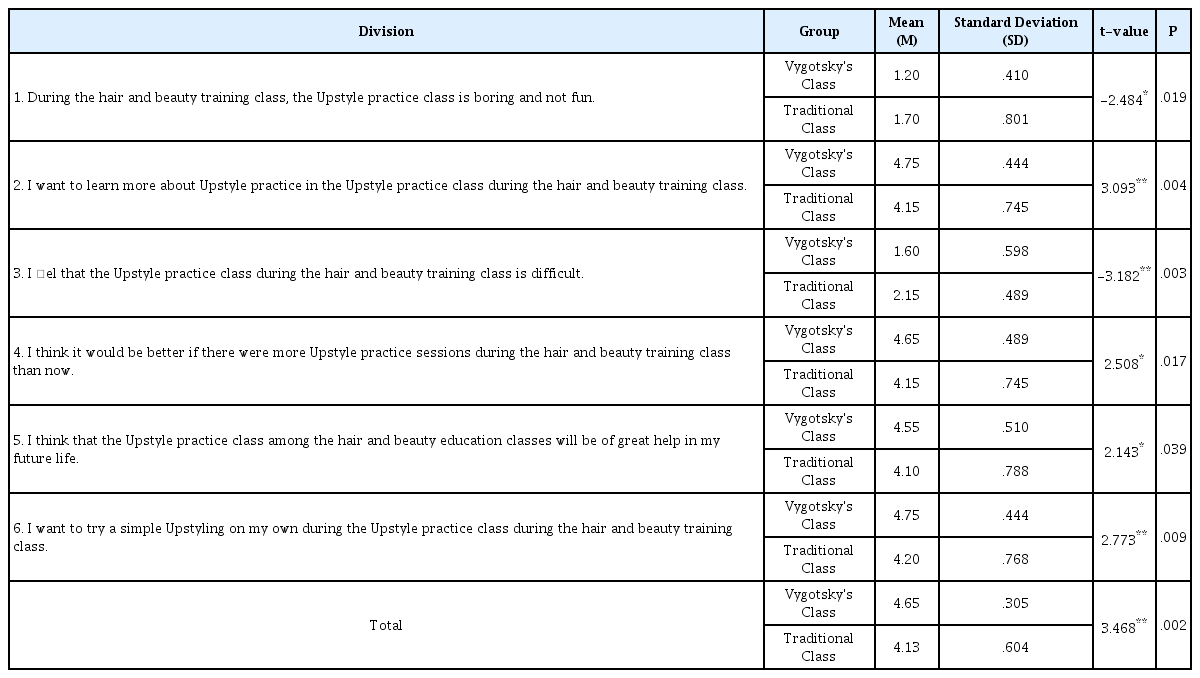
Differences in interest level between classes using Vygotsky's zone of proximal development and traditional classes
먼저 전반적인 흥미도에 있어서는 비고츠키의 근접발달영역을 활용한 수업(M=4.65)의 경우 전통적이 수업(M=4.13)에 비해 상대적으로 높은 것으로 나타났다. 또한 각 하위문항 ‘나는 헤어미용교육시간 중 업스타일 실습 시간이 지루하고 재미없다.’에 있어서는 전통적 수업(M=1.70)의 경우 비고츠키의 근접 발달영역을 활용한 수업(M=1.20)에 비해 상대적으로 높은 것으로 나타났고, ‘나는 헤어미용 교육시간 중 업스타일 실습 시간에 더 많은 업스타일 실습을 배우고 싶다.’ 에 있어서는 비고츠키의 근접발달영역을 활용한 수업(M=4.75)의 경우 전통적인 수업(M=4.15)에 비해 상대적으로 높은 것으로 나타났다.‘나는 헤어미용 교육시간 중 업스타일 실습 시간이 어렵다고 느낀다 .’에 있어서는 전통적이 수업(M=2.15)의 경우 비고츠키의 근접 발달영역을 활용한 수업(M=1.60)비해 상대적으로 높은 것으로 나타났고, ‘나는 헤어미용 교육시간 중 업스타일 실습시간이 지금보다 더 많았으면 좋겠다고 생각한다.’에 있어서는 비고츠 키의 근접발달영역을 활용한 수업(M=4.65)의 경우 전통적이 수업(M=4.15)에 비해 상대적으로 높은 것으로 나타났다. ‘나는 헤어미용 교육시간 중 업스타일 실습 시간이 앞으로 살아가는 데 많은 도움이 될 것이라고 생각한다.’에 있어서는 비고츠키의 근접발달영역을 활용한 수업(M=4.55)의 경우 전통적인 수업(M=4.10)에 비해 상대적으로 높은 것으로 나타났고, ‘나는 헤어미용 교육시간 중 업스타일실습 시간에 간단한 업스타일을 내가 스스로 해보고 싶다.’에 있어서는 비고츠키의 근접발달영역을 활용한 수업(M=4.75)의 경우 전통적인 수업(M= 4.20)에 비해 상대적으로 높은 것으로 나타났다.
즉, 전체적으로 볼 때, 비고츠키의 근접발달영역을 활용한 수업의 경우 전통적인 수업대비에 상대적으로 흥미도가 높은 것으로 볼 수 있다. 또한 Ryu(2010)의 연구에서는 Vygotsky의 근접발달영역 개념을 도입하여 비계설정 방법을 분석 내용을 실제 수업에 적용할 수 있도록 설계하는 데에 개발된 프로그램은 국악 창작에 대한아동의 흥미도와 관심도 등을 높이는 영향을 주었으며, 국악에 대한 선호도가 향상되었다는 연구 결과와 맥을 같이 한다.
5. 비고츠키의 근접발달영역을 활용한 수업과 전통적인 수업의 학습태도 차이
비고츠키의 근접발달영역을 활용한 수업과 전통적인 수업의 학습태도에 차이가 있는지 알아보기 위하여 독립표본 t-test를 실시한 결과는 Table 10과 같다. 분석결과 전반적인 학습태도와 하위 문항별 ‘나는 헤어미용교육시간 중 업스타일 실습 시간에 궁금한 점이나 모르는 점이 있으면 바로 질문한다.’, ‘나는 헤어미용 교육시간 중 업스타일 실습 시간에 잘못 따라하는 친구들이 있으면 도와주고 싶다.’, ‘나는 헤어미용 교육 시간 중 업스타일 실습 시간 중에 업스타일 실습한 것을 상황에 응용해 보고싶다.’, ‘나는 헤어미용 교육시간 중 업스타일실습 시간 중에 실습하는 것이 좋고 열심히 노력한다.’, ‘나는 헤어미용 교육시간 중 업스타일 실습 시간에 다른 친구들과 잡담을 하지 않는다.’, ‘나는 헤어미용 교육시간 중 업스타일 실습 시간에 다른 친구들이 하는 것만 지켜보는 편이다.’에 대해 통계적으로 유의미한 차이가 나타났다(p<.05).
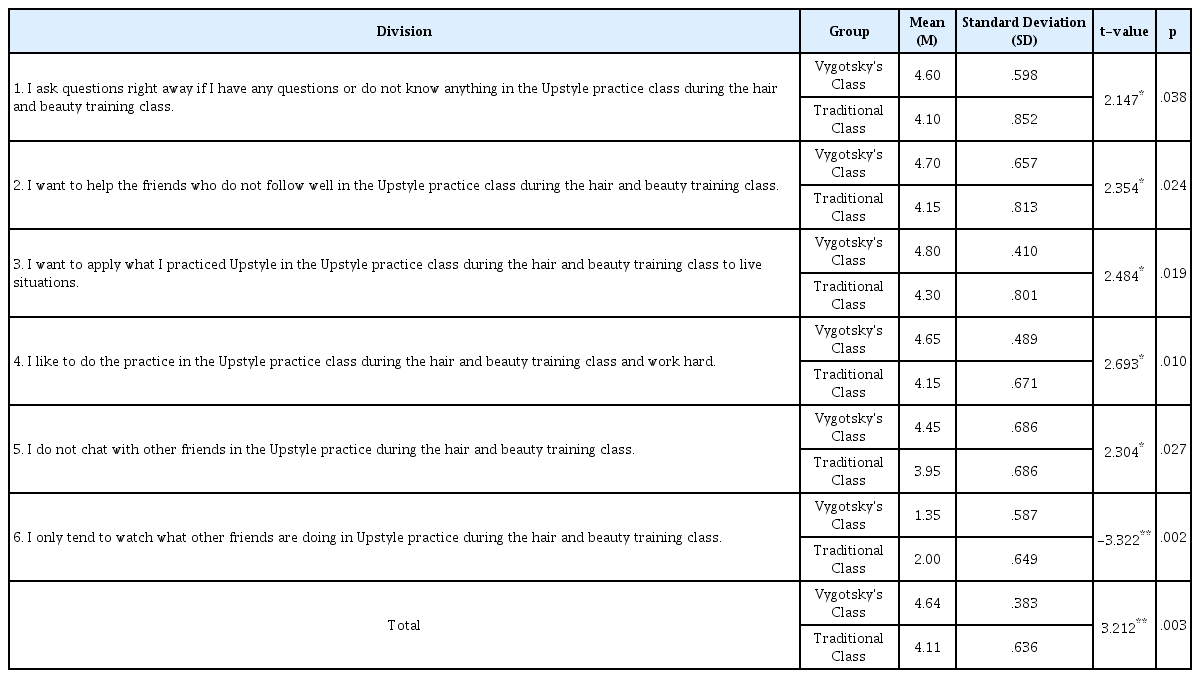
Differences in learning attitudes between classes using Vygotsky's zone of proximal development and traditional classes
먼저 전반적인 학습태도에 있어서는 비고츠키의 근접발달영역을 활용한 수업(M=4.64)의 경우 전통적이 수업(M=4.11)에 비해 상대적으로 높은 것으로 나타났다. 또한 각 하위 문항별 ‘나는 헤어미용 교육시간 중 업스타일 실습시간에 궁금한 점이나 모르는 점이 있으면 바로 질문한다.’에 있어서는 비고츠키의 근접발달영역을 활용한 수업(M=4.60)의 경우 전통적인 수업(M=4.10)에 비해 상대적으로 높은 것으로 나타났고, ‘나는 헤어미용 교육시간 중 업스타일 실습 시간에 잘 못 따라하는 친구들이 있으면 도와주고싶다.’에 있어서는 비고츠키의 근접발달영역을 활용한 수업(M=4.70)의 경우 전통적이 수업(M=4.15)에 비해 상대적으로 높은 것으로 나타났다. ‘나는 헤어미용 교육시간 중 업스타일 실습 시간 중에 업스타일 실습한 것을 생활에 응용해 보고 싶다.’에 있어서는 비고츠키의 근접발달영역을 활용한 수업(M=4.80)의 경우 전통적인 수업(M=4.30)에 비해 상대적으로 높은 것으로 나타났고, ‘나는 헤어미용 교육시간 중 업스타일 실습시간 중에 실습하는 것이 좋고 열심히 노력한다.’에 있어서는 비츠키의 근접발달영역을 활용한 수업 (M=4.65)의 경우 전통적인 수업(M=4.15)에 비해 상대적으로 높은 것으로 나타났다. ‘나는 헤어미용 교육시간 중 업스타일 실습 시간에 다른친구들과 잡담을 하지 않는다.’에 있어서는 비고츠키의 근접발달영역을 활용한 수업(M=4.45)의 경우 전통 적인 수업(M=3.95)에 비해 상대적으로 높은 것으로 나타났고, ‘나는 헤어미용 교육시간 중 업스타일실습 시간에 다른 친구들이 하는 것만 지켜보는 편이다.’에 있어서는 전통적이 수업(M=2.00)의 경우 비고츠키의 근접발달영역을 활용한 수업(M=1.35)에 비해 상대적으로 높은 것으로 나타났다.
즉, 전체적으로 볼 때, 비고츠키의 근접발달영역을 활용한 수업의 경우 전통적인 수업에 비해 상대적으로 학습태도가 높은 것으로 볼 수 있다.
Kang(2007)는 논문은 비고츠키의 근접발달영역을 고려한 수학과 교수·학습 프로그램 연구는 연구자가 개발한 교수학습 프로그램적용은 실험집단, 일반적인 교수학습방법은 비교집단으로 학업성취도 검사와 학습태도 검사 결과로서 연구자가 개발한 일반적인 학급에서 교수학습 프로그램적용이 수학에 대한 학업성취도와 학습태도에 향상에 긍정적인 의미의 영향력이 있고 더욱 효과적으로 나타났다. 그리고 Kim(2011)의 연구에서도 영어능력발달 연구에서는 수업 과정에서 비계설정의 적용이 아동들의 학습태도에 긍정적인 변화를 가져올 수 있었다. 영어 능력발달이 학습태도에 미치는 영향이 있다는 것을 알 수 있다. 따라서 비계설정에서 발전된 결과가 나타났다고 하여 본 결과랑 일치되는 것을 알 수 가 있었다.
6. 비고츠키의 근접발달영역을 활용한 수업과 전통적인 수업의 업스타일 실기평가차이
비고츠키의 근접발달영역을 활용한 수업과 전통적인 수업의 업스타일 실기평가에 차이가 있는지를 알아보기 위하여 독립 표본 t-test를 실시한 결과는 Table 11과 같다. 분석결과 전반적인 업스타일 실기평가와 하위영역별 ‘베이직 업스타일 준비 상태’, ‘베이직 업스타일 시술진행과정’, ‘베이직 업스타일’, ‘베이직 업스타일 및 자세’, ‘베이직 업스타일 완성도 및 조화미’ 에 대해 통계적으로 유의미한 차이가 나타났다(p<.05).
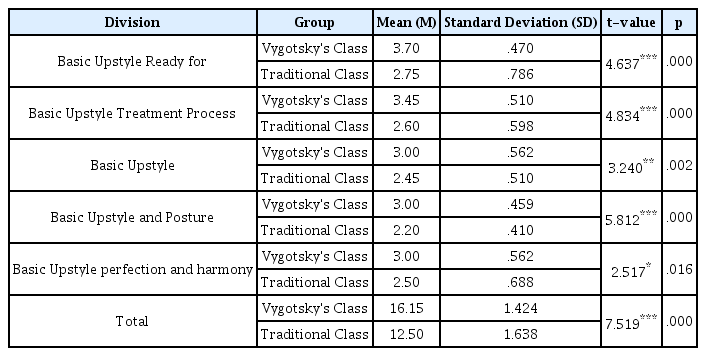
Differences in upstyle practical evaluation between classes using Vygotsky's zone of proximal development and traditional classes
먼저 전반적인 업스타일 실기평가에 있어서는 비고츠키의 근접발달영역을 활용한 수업(M=16.15)의 경우 전통적이 수업 (M=12.50)에 비해 상대적으로 높은 것으로 나타났다. 또한 각 하위영역별 ‘베이직 업스타일 준비상태’에 있어서는 비고츠키의 근접발달영역을 활용한 수업(M=3.70)의 경우 전통적이 수업(M=2.75)에 비해 상대적으로 높은 것으로 나타났고, ‘베이직 업스타일 시술진행 과정’에 있어서는 비고츠키의 근접발달영역을 활용한 수업(M=3.45)의 경우 전통적이 수업(M=2.60)에 비해 상대적으로 높은 것으로 나타났다. ‘베이직 업스타일’에있어서는 비고츠키의 근접발달영역을 활용한 수업(M=3.00)의경우 전통적인 수업(M=2.45)에 비해 상대적으로 높은 것으로 나타났고, ‘베이직 업스타일 및 자세’에 있어서는 비고츠키의 근접발달영역을 활용한 수업(M=3.00)의 경우 전통적이 수업 (M=2.20)에 비해 상대적으로 높은 것으로 나타났으며, ‘베이직 업스타일 완성도 및 조화미’에 있어서는 비고츠키의 근접발달영역을 활용한 수업(M=3.00)의 경우 전통적이 수업(M=2.50)에 비해 상대적으로 높은 것으로 나타났다. 즉, 전체적으로 볼 때, 비고츠키의 근접발달영역을 활용한 수업의 경우 전통적인 수업에 비해 상대적으로 업스타일 실기평가가 높은 것으로 볼 수 있다.
V. 결 론
본 연구는 교과를 지도하는데 있어서 기존보다 학습자의 발달을 고려하여 좀 더 효과적인 교수-학습을 고민하는데서 출발하였다. 그러던 중 비고츠키의 교육관을 마주하게 되었고 그의 많은 이론 중 근접발달영역을 활용하여 헤어미용교육에 접목시켰을때 어떠한 영향을 미칠지 궁금증을 유발하였다. 근접발달영역은 학습자의 발달 수준을 나타내는 지표로써 학습자의 ‘실제적 발달 수준’을 ‘잠재적 발달 수준’까지 끌어올리기 위해 교사 또는 동료와 협력하여 해결하는 발달과업의 기능이라고 볼 수 있다. 이와 같이 헤어미용교육의 교과를 근접발달영역을 활용한 교수-학습을 통해 학습자발달을 도출하는데 목적이 있다. 본 연구를 정리하자면 실제 훈련을 통해 비고츠키의 근접 발달영역을 활용한 헤어미용실습 교과의 학습자 발달에 긍정적인 반응을 초래하였다.
본 연구에서 프로그램은 학습자의 협동학습을 통해 수업의 흥미도, 학습태도 및 실기평가를 조사했더니 전체적으로 볼 때, 비고츠키의 근접발달영역을 활용한 수업의 경우 전통적인 수업에 비해 상대적으로 흥미도, 학습태도, 실기평가의 결과가 높게 나타난 것으로 볼 수 있다. 교사와 학생, 학생과 학생 간의 협력과 모방을 통해 근접발달영역을 창출하여 예술적 발달과 업을 이루기 위함이다. 이러한 교수-학습의 조건을 위해서 교사는 창의적인 환경을 조성해야 한다. 교사는 권위적이고 감독적인 역할에서 벗어나 학생과 상보적 관계가 되어 대화를 통해 적절한 도움을 제공해야 한다. 그리고 학생이 어려운 문제를 해결하지 못할때 끊임없이 질문을 던져 답에 가까워질 수 있도록 유도하고 칭찬과 격려를 아끼지 않는다. 또한 모둠별로 나누어 협력을 통해 과제를 해결할 수 한다.
즉 모둠으로부터 학생 개인에게 지식이 내면화가 될 때까지 이러한 과정을 순환한다. 이러한 업스타일실습 교육은 기존의 교육보다 훨씬 많은 시간을 소모시킬 수 있다. 본 연구에 참여한 교사와 학생 모두 과제를 해결하기까지 인내를 가지고 기다렸기 때문이다. 그렇지만 본 연구를 통해 교사와 학생 간에는 신뢰와 믿음이 생겼고 나아가 지식 수준이 전체적으로 향상되어 일정 수준평균화 된 양상을 보였다. 따라서 본 연구는 학습자의 전인적 발달에 효과적이며 이러한 연구의 성패는 교사의 학생에 대한 애정과 관심, 학생의 의식과 의지가 교수-학습에 적극적이어야 한다. 헤어미용교육은 앞으로도 발전할 것이다. 다만 이전과 같은 주입식 교육이 아닌 창의적이고 종합적인 형태로 매개된 활동을 이어나가며 표현하고 공유하는 교육이 되길 희망한다. 아울러 비고츠키의 이론을 활용한 헤어미용교육이 지속적으로 연구되어 지길 제언하는 바이다.
